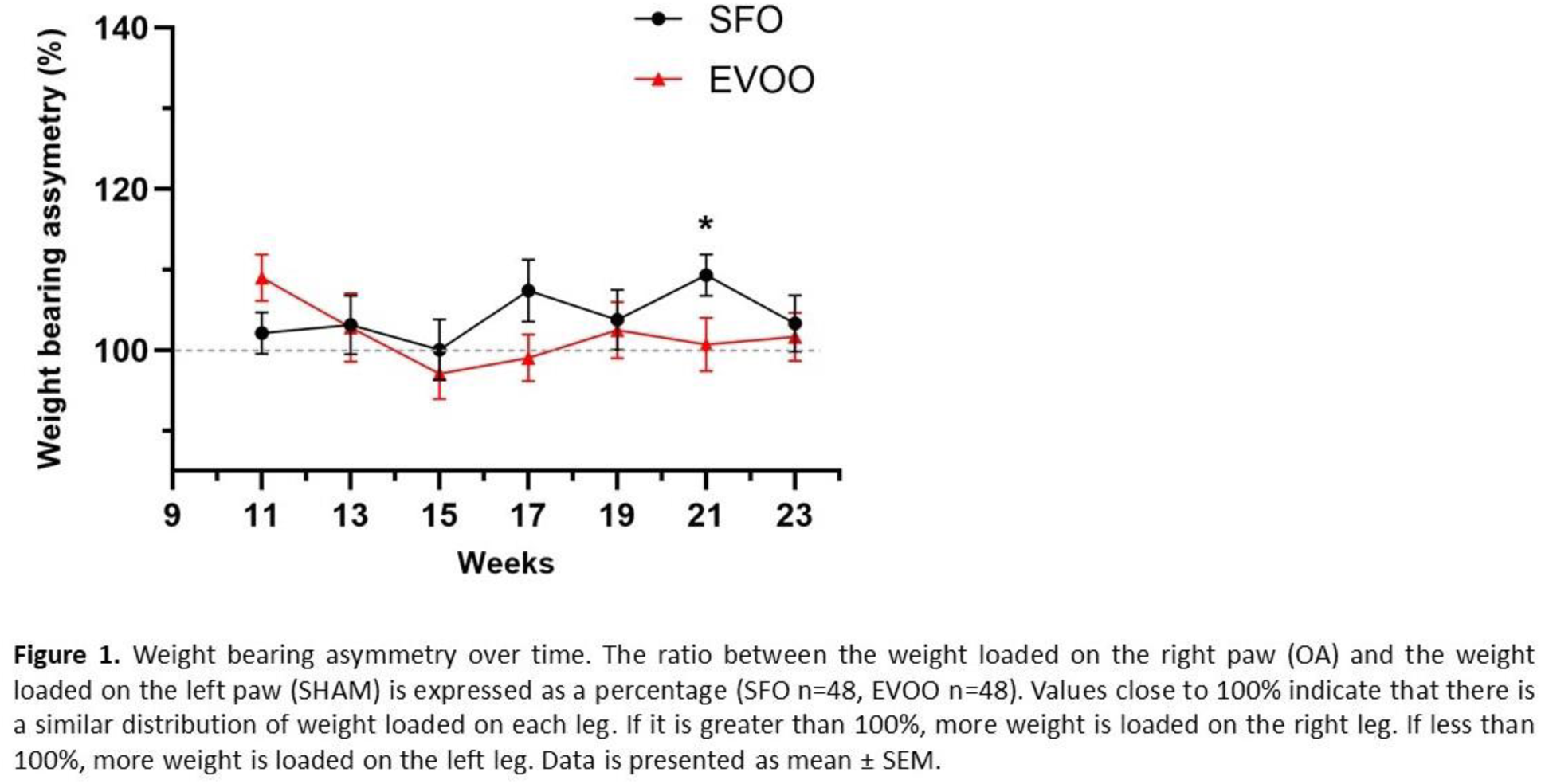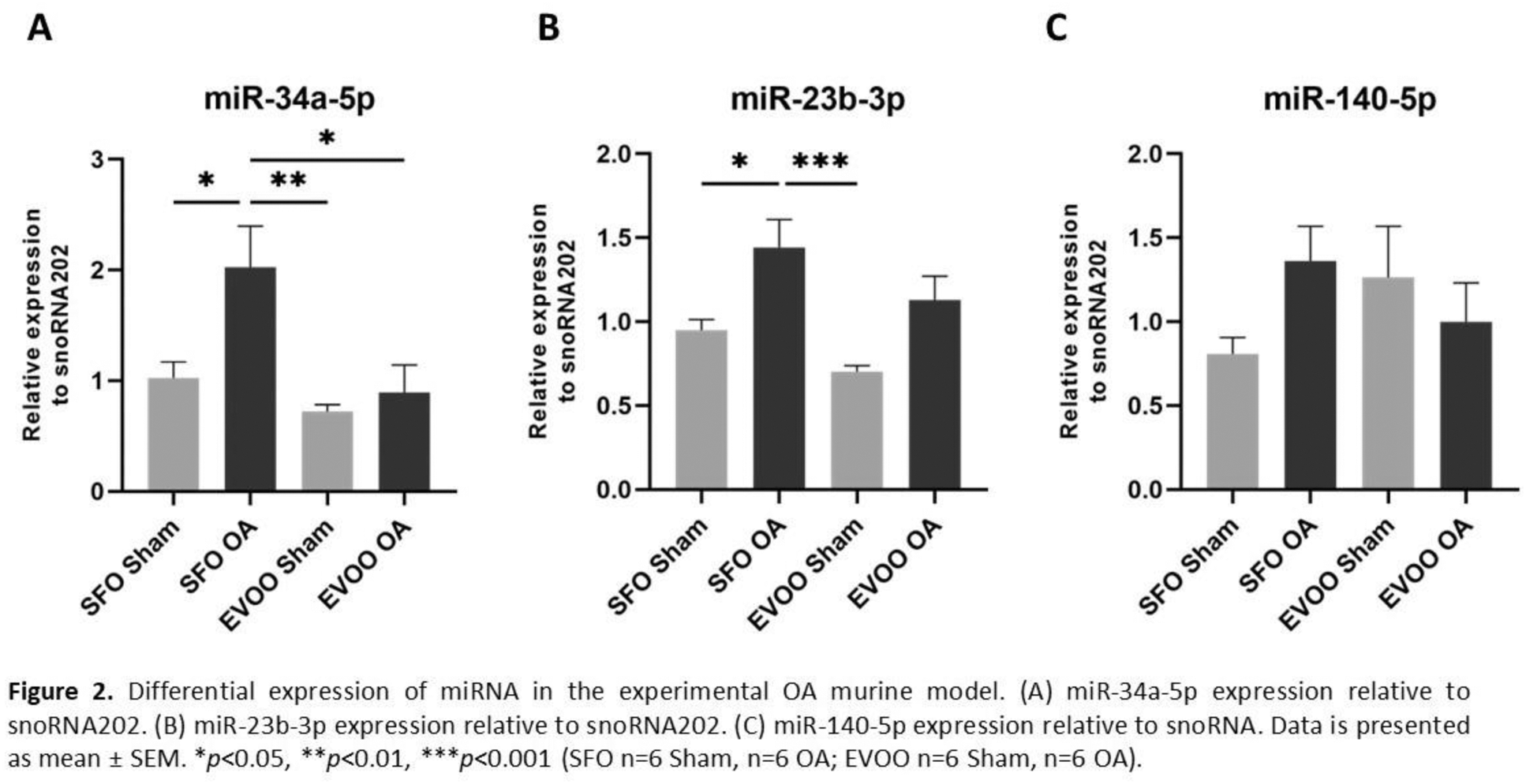

Background: Mediterranean diet is associated with a healthier lifestyle and lower incidence of osteoarthritis (OA), one of the most prevalent diseases worldwide among the elderly [1] . Extra virgin olive oil (EVOO) is a key component of this nutritional model. EVOO contains polyphenols that, in addition to their antioxidant and anti-inflammatory effects, could be acting as epigenetic modulators [2] . Therefore, EVOO could potentially be used as a preventive treatment to attenuate or slow down the progression of OA. Recent evidence shows that miRNAs are critical to the maintenance of cartilage homeostasis [3-5] and these could be susceptible to changes in diet.
Objectives: The study aimed to compare the effects of dietary supplementation of mice with surgically induced OA with sunflower oil (SFO) or EVOO. For this purpose, variations in postural symmetry and analysis of the expression profile of OA and inflammation related miRNAs were evaluated.
Methods: Three-weeks-old C57BL/6 male mice were randomized into two experimental groups immediately after weaning to follow a specific diet for their entire life until euthanasia: (1) Diet enriched with 10% SFO, (2) Diet enriched with 10% EVOO. Transection of the medial meniscotibial ligament and the medial collateral ligament was surgically performed in 12-weeks-old mice to induce OA. Each individual had one OA knee and one SHAM-operated knee. Mice were fed for 12 weeks after surgery. Postural symmetry was measured with SWB-Touch (Bioseb) and SEDACOM (Panlab) software every two weeks (SFO n=48, EVOO n=48). Data were processed using GraphPad Prism 8. Cartilage was extracted from three knees of mice belonging to the same experimental group and pooled (SFO n=6 Sham, n=6 OA; EVOO n=6 Sham, n=6 OA). RNA isolation was performed using the AllPrep DNA/RNA/miRNA Universal Kit (QIAGEN). OA-associated miRNAs (let-7c-5p, miR-126-3p, miR-128a-3p, miR-130-3p, miR-138-5p, miR-140-5p, miR-145-5p, miR-146a/b, miR-155, miR-23b-3p, miR-24-3p, miR-320, miR-34a-5p) were reversed transcribed and expression was analyzed with TaqMan Technology by qPCR. Data were processed with qbase+ v3.4 software.
Results: SFO-fed mice presented a significantly more asymmetrical posture than EVOO-fed mice, loading more weight on the right paw in comparison to the left paw at 21 weeks of age (109.30±2.57 vs. 100.68±3.33, p =0.0121). The trend is maintained over time, with EVOO-fed mice having a postural symmetry closer to 100% than SFO-fed mice (Figure 1). After miRNA analysis we found that miR-34a-5p expression was significantly increased in the SFO OA group compared to the SFO SHAM group (2.03±0.37 vs. 1.02±0.15, p =0.03). The correlation was maintained in the EVOO group. However, miR-34a-5p levels were significantly downregulated in EVOO OA compared to SFO OA (0.89±0.25 vs. 2.03±0.37, p =0.01) (Figure 2A). miR-23b-3p was significantly upregulated in SFO OA in contrast to SFO SHAM (1.44±0.17 vs. 0.95±0.06, p =0.03). The same tendency was found between the EVOO OA and EVOO SHAM groups (1.13±0.14 vs. 0.70±0.04), although the expression of miR-23b-3p was lower than in SFO OA and SFO SHAM (1.13±0.14 vs. 1.44±0.17; 0.70±0.04 vs. 0.95±0.06) (Figure 2B). No significant changes in miR-140-5p expression were observed (Figure 2C).
Conclusion: Our results show that EVOO helps to maintain postural symmetry over 23 weeks. Moreover, miR-34a-5p, considered to have detrimental effects in OA, is significantly reduced in mice that followed an EVOO-enriched diet, whereas its expression was increased in mice with an SFO-enriched diet. miR-23b-3p levels are also increased with SFO intake, whereas they tend to be slightly reduced with EVOO. We conclude that a healthy diet including EVOO could help delay the onset of OA by acting on the regulation of epigenetic mechanisms and improving postural symmetry, which could potentially alleviate joint pain.
REFERENCES: [1] Veronese et al., Clin. Nutr. 36, (2017).
[2] Ayissi et al., Mol. Nutr. Food Res. 58, (2014).
[3] Miyaki et al., Genes Dev. 24, (2010).
[4] Yamasaki et al., Arthritis Rheum. 60, (2009).
[5] Ali et al., Ther. Adv. Musculoskelet. Dis. 14, (2022).


Acknowledgements: NIL.
Disclosure of Interests: None declared.